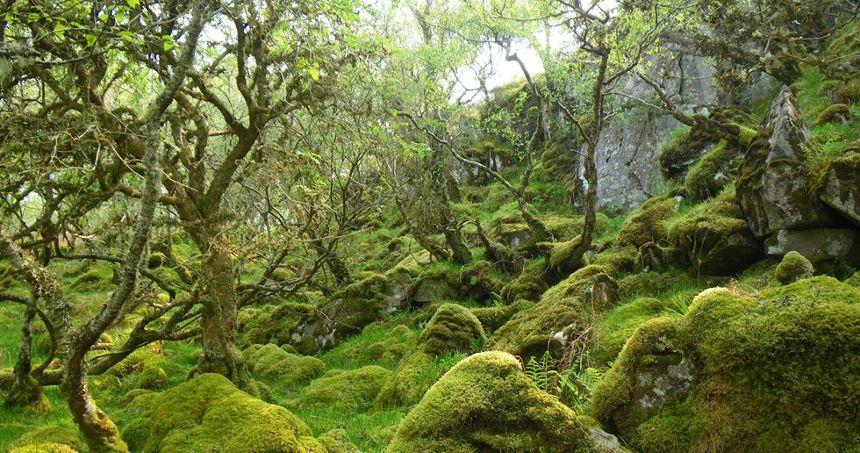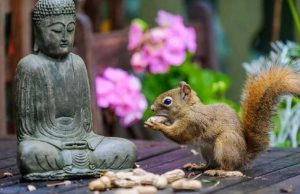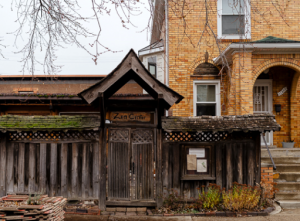
By walking one makes the road,
Antonio Machado
and upon glancing back
one sees the path
that will never be trod again.
Wanderer, there is no road—
Only foam in the sea.
Every few months I feel the urge to leave the business and distractions of city life behind for a retreat into the countryside, all by myself. Solitude and connection with nature serve to refresh my art and writing practice and allow me to go deeper in meditation, and it’s a relief to compose my email “away” notice. Roz, a sangha friend from the Scottish Highlands, has made her cottage in Ardnamurchan available for solitary retreats and, fortuitously, it is free when I need it. It is situated close to the shore of Loch Sunart and, while warm and comfortable, the décor breathes an old-fashioned aesthetic of patterns and styles.
Roz recently inherited the cottage from her mother and plans to refurbish it at some point. I feel grateful not to have any such responsibilities here and can just get on with my practice, whatever that may turn out to be. I swiftly rearrange things to suit my purposes, shuffle the expandable dining table from the dark kitchen into the lounge, cover it with a cut-open, splash-proof black trash bag, and set up a shrine in the second bedroom facing out toward the loch. I have brought a bunch of yellow tulips that I split between two vases, hugging Roz’s big wooden Buddha. Over my week here they gradually grow plumper, without quite fully opening.
Sunart is famous for its pockets of Atlantic rainforest, and during the first couple of days I seek out those wild places where boundaries between tree trunks and boulders disappear beneath the all-pervasive spread of a plush, moist fleece of mosses. Oaks are just opening their orange-tinted buds—the same color as the Highland cattle on the field next to the cottage—some already turning golden-green, the most richly hopeful of hues. The cuckoo calls and butterflies tumble giddily about—it’s not raining, for once! This is what I have been longing for: nestling in the fragrant, thick, spongy forest floor (on my waterproof coat), head resting on a stone pillar, cushioned by sphagnum moss. The lines of Mary Oliver’s poem “Sleeping in the Forest” fill my mind like a mantra:
I thought the earth remembered me,
she took me back so tenderly,
arranging her dark skirts, her pockets
full of lichens and seeds.
I feel safe in this relative wilderness, just out of reach of traffic sounds, in touch with a primordial connectedness that calls me, “so tenderly,” to surrender into the self-forgetting of sleep. On waking, I find that the connection with mother earth has deepened into a slow-gazed, soft-fingered contentment. I linger to caress her multihued, sun-dappled, pliant green skin, before getting up and doing something a little more purposeful, like walking home for lunch and doing some artwork or meditating.
While I sometimes enjoy the simplicity of listening to recorded meditations, where “I” have to make fewer choices myself, it is clear after a while, that I need to trust my own guiding voice. And certainly guidance is needed, as there are points along the way when it is easy for self-confidence to waver. In both artmaking and meditating it can be daunting, for example, to face the inevitable periods of uncertainty, of not knowing what to do or where to go next, or to what overall purpose. Some inner parts like to step into that gap, an inner standard-setter or result-seeker, and they create, despite their good intentions, a tense atmosphere that is not conducive to the flow of creative energy. Somehow, they need to be integrated into the process, just chucking them out of the way won’t work. As artists and meditators we have to come to value these explorations of the “underland,” as Robert MacFarlane calls it. Whether we literally explore caves and catacombs, or see it more metaphorically, “into the underland we have long placed that which we fear and wish to lose, and that which we love and wish to save.” (Macfarlane, 8)

One day, toward the end of the week, I set myself up with a little writing table in front of my meditation place and put into language some of these often wordless inner exhortations, those subtle nudges in certain directions. I found much of it equally pertinent to meditation and the creative arts, and probably to other aspects of life as well.
- Connect with your intention and hold it lightly. Make this part of the intention. It is obvious that you are trying to do something, as you have arranged yourself into some meditation posture, lit a candle and incense, or set out some paper and materials and fastened your painting apron. It is understandable to feel a little daunted at this stage, as you are stepping out of the world of familiar task-orientation into a different zone, one that is calling for a less utilitarian mindset. Don’t cover up any transitional, uncomfortable feelings by adopting a false, strident certainty about your purpose. You only set yourself up for struggle and disappointment. Instead, gently affirm what propels you toward an emergent transformation, open up to the unknown, and salute your courage. Maybe there are certain, specific ideas you want to pursue, but let it all be quite provisional. You may find the most useful intentions have to do with maintaining a continuity of awareness qualities, such as openness and curiosity. Sometimes you may want to remember, without grasping, the subtle sense of inspiration that has lifted you into a state of absorption before.
- Trust the rhythm of your momentum. While much is unknown, at the same time, you are not starting from scratch. You have built a momentum through your previous sessions, developed some expertise in certain creative techniques, familiarized yourself with some meditative steppingstones, and you have to start somewhere. So you might just cover the paper with some watery inks you like the look of, let it all flow, cover the ground, get something going. It almost certainly will be covered up again, as layers build on each other. When writing, you may start with a period of timed, free-flowing, continuous movements of the pen, just putting words on paper. In meditation it’s a good idea to just sit for a while, with whatever is happening, without intervening, and then spend time to connect your posture with the energies of earth and sky, stability and freedom. In this way, by repeatedly going over those familiar inner or outer movements, confidence grows.
- Let it all be quite ordinary and sense-based. Wanting to have a special experience in meditation or to produce a masterpiece usually backfires. There is a lot of “selfing” involved, which, upon deeper enquiry, reveals itself to be the reluctance to experience what is actually going on: a continuous flow of experience, some pleasant, some unpleasant, most of it unremarkable. A primary characteristic of this flow is its impermanence, the one thing the self can’t easily come to terms with. So it creates inner scenarios, stories that have nothing to do with this present, transitory moment. It can be a relief to let go of any grandiose ideas of achieving fame or hopes for love and acknowledgement, or the simmering fear that such desires may remain unfulfilled, and instead knuckle down to the detail of observed experience: the way two colours interact with each other on the paper, the way a phrase echoes against another, the felt sense of the hands in touch with each other, the woven meditation blanket and the coolness of the air.
- Lose yourself. Sometimes the self, as a fixed sense of identity, is absent quite naturally, with all of you fully absorbed in the activity. When you are a bit dreamy, there isn’t much selfing there either. Get used to what that feels like and don’t comment on it too loudly, if at all. We can relax into being aware without there being much of a separate observer and simply allow the delightful, effortless unfolding of creative processes.
If you are interested in hearing more about this enquiry into similarities of artmaking and meditation, check out the next instalment in this column, which will cover topics such as embracing the shadow, persisting through the doldrums, honoring our teachers, and stopping when the going is good.
References
Macfarlane, Robert. 2020. Underland: A Deep Time Journey. New York: W. W. Norton & Company.
Related features from BDG
The Joy of Renunciation – In Retreat and in Everyday Life
Touching the Earth: An Ecodharma Retreat
Retreating into the World: the Ultimate Spiritual Practice
Tale of Three Whales: Life after Long Retreat
Mindfulness, Breathing, and Walking: Reflection after a Thich Nhat Hanh Retreat.














